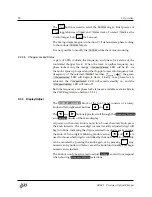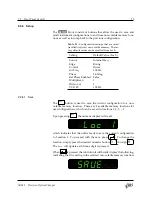
44
3 Remote Operation
3.3
Introduction
Remote operation of the SR542 is through a simple command language
documented in this chapter. Both set and query forms of most com‑
mands are supported, allowing the user complete control of the SR542
from a remote computer via a USB interface.
Where applicable, the corresponding front‑panel interface to each com‑
mand is also indicated. Most instrument settings are retained in non‑
volatile memory. Upon power‑on, these settings are restored to their
values from before the power was turned off. Where appropriate, the
default value for parameters is listed in
boldface
in the command de‑
scriptions. These default values are restored by a factory reset (
*RST
),
or when recalling memory location 0.
3.3.1
Interface Configuration
The USB interface is implemented as a serial port emulator, with fixed
rate of 115,200 baud, 8 data bits, no parity or flow control.
The front‑panel indicator
USB
indicates remote interface activity (both
incoming and outgoing messages).
3.3.2
Remote Interface Buffers
The SR542 stores incoming bytes received via the USB interface in a 256‑
byte input buffer. Characters accumulate in the input buffer until a com‑
mand terminator (
⟨
CR
⟩
or
⟨
LF
⟩
) is received, at which point the message
is parsed and the corresponding command(s) is (are) executed. Query
responses from the SR542 are buffered into a 256‑byte output buffer.
If the input buffer overflows, then an INPUT BUFFER OVERRUN er‑
ror is added to the error queue and the INP bit is set in the ESR status
register. All data in the input buffer are cleared.
3.4
Commands
This section provides syntax and descriptions for all remote commands.
3.4.1
Command Syntax
The four letter mnemonic (shown in
CAPS
) in each command sequence
specifies the command. Depending on the command, the mnemonic can
be followed by zero to three parameters.
Commands may take either
set
or
query
form, depending on whether
the “
?
” character follows the mnemonic.
Set only
commands are listed
without the “
?
”,
query only
commands show the “
?
” after the mnemonic,
and
optionally query
commands are marked with a “
(?)
”.
SR542 Precision Optical Chopper






























